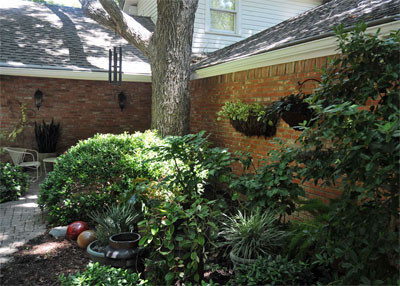From the Sperry Gardens – July, 2011

My wife and I bought the rural property where we live 40 years ago this fall. The 11 acres were covered in pecan trees – and scores of red cedars, with several nice oaks, cedar elms, soapberries and other assorted natives. So, finding a spot where we could build our home presented some challenges. After all, we didn’t want to remove trees in the process.
We hired an architect, and the spot he selected was nestled among several large pecan trees. The one you see was not one of them. It was a comparatively small 8-inch-diameter tree at the time, and the house was to be about 36 inches from its trunk. Special core borings were taken, and deep structural piers were to be poured to be sure the house didn’t move on the heavy clay soils.
That was when I got called out of town. It was spring, and I was still employed by the Texas Agricultural Extension Service. (I still prefer that name.) I was gone for a week, and when I returned, to my dismay, 8 inches of soil had been scraped off the ground around this tree, and the slab had been framed and poured – 18 inches closer to the tree than it was supposed to be! Oh, my.
I quickly gathered the soil back up around its roots, and I applied a liquid root-stimulator. I made sure it didn’t dry out that entire first summer, yet it still lost all of its leaves by early September. I figured our tree was a goner.
But, it leafed out the next spring, and it seemed to have a fairly full canopy of foliage. Best of all, its leaves hung on until normal leaf drop in late October. I was feeling redeemed.
The next year, our tree started to grow. It put on two feet of new shoots that year (1980 – a summer to end all summers), and it remained handsome and healthy. It has never looked back.
Now, it’s by far the largest pecan on our property. It towers over almost all of our two-story house. The photo doesn’t do justice to its true size, so I went back out with a yardstick just now. This tree is 26 inches in diameter at chest height. Two of us can reach around it. Three years ago, it started pressing into the guttering. We had the company come back to remove a short section and convert the guttering into two separate areas. Eventually, it’s going to bang into our eave. I’ve already decided that we’ll just do a remodel at that point. I’m going to make sure that nothing bad will happen to our majestic old pecan tree. I can’t imagine our landscape without it.
We have landscape lighting high in this tree. (Lentz Landscape Lighting) It illuminates our drive, and it’s the light by which we entertain on summer evenings. The arborists who do all the work at my home have been in this tree many times, making sure all systems are go. If we ever have to cable and brace it, we will. (Arborilogical Services)
So, you’re asking yourself, "How about that slab foundation, Neil? How do it and tree get along?" As odd as it may seem, we have never had any trouble in that part of our house. We had my sponsoring foundation repair company (Advanced Foundation Repair) do some work on another part of the house, but it was well beyond the area of influence of this tree’s roots. Way back when this tree had been virtually unearthed, I removed a fairly significant root that was headed right toward the concrete, and that one trim seems to have made quite a difference.
I talk about this tree frequently on the air and in my writings, so I thought you might enjoy seeing it in our landscape. Plus, it was only 20 steps out into the heat. I’ll venture farther out when it’s cooler.

